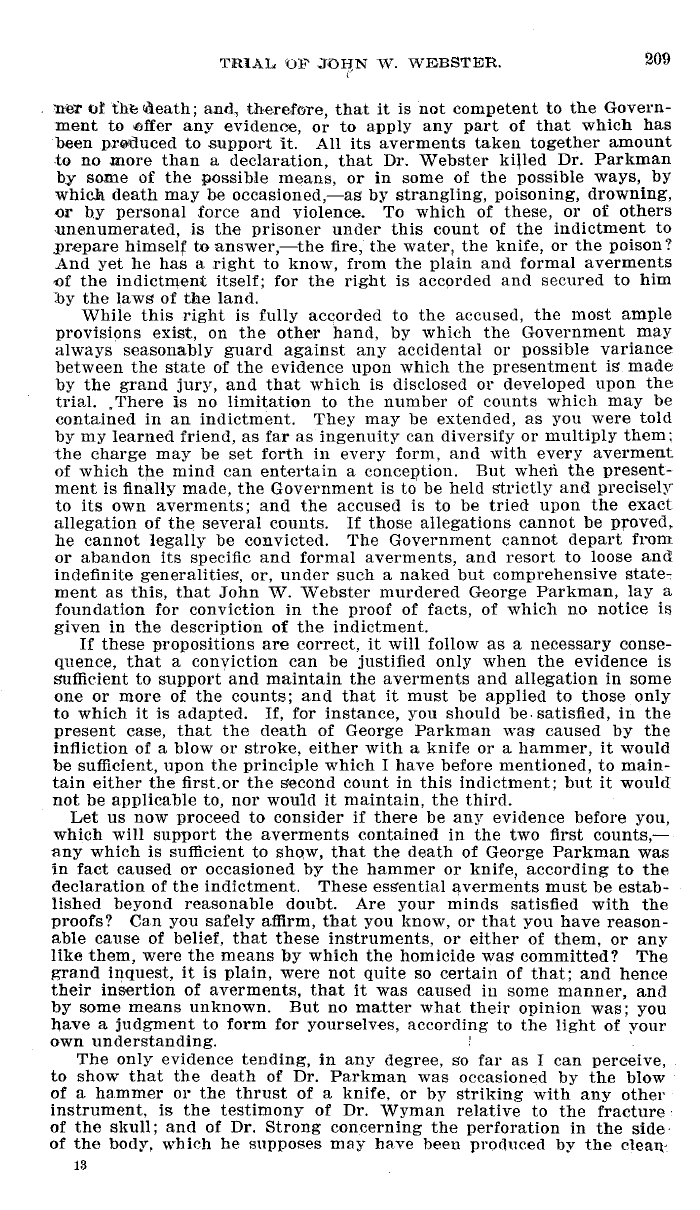|
TRIAL "OF JOHN W. WZBSTER. 209
uer fit the (death; and, therefore, that it is not competent to the Govern-
ment to offer any evidence, or to apply any part of that which has
been produced to support it. All its averments taken together amount
to no more than a declaration, that Dr. Webster killed Dr. Parkman
by some of the possible means, or in some of the possible ways, by
whick death may be occasioned,-as by strangling, poisoning, drowning,
or by personal force and violence. To which of these, or of others
unenumerated, is the prisoner under this count of the indictment to
.prepare himself to answer, the fire, the water, the knife, or the poison?
And yet he has a sight to know, from the plain and formal averments
of the indictment itself; for the right is accorded and secured to him
by the laws of the land.
While this right is fully accorded to the accused, the most ample
provisions exist, on the other hand, by which the Government may
always seasonably guard against any accidental or possible variance
between the state of the evidence upon which the presentment is made
by the grand jury, and that which is disclosed or developed upon the
trial. .There is no limitation to the number of counts which may be
contained in an indictment. They may be extended, as you were told
by my learned friend, as far as ingenuity can diversify or multiply them;
the charge may be set forth in every form, and with every averment
of which the mind can entertain a conception. But when the present-
ment is finally made, the Government is to be held strictly and precisely
to its own averments; and the accused is to be tried upon the exact
allegation of the several counts. If those allegations cannot be proved,
he cannot legally be convicted. The Government cannot depart from
or abandon its specific and formal averments, and resort to loose and
indefinite generalities, or, under such a naked but comprehensive state-
ment as this, that John W. Webster murdered George Parkman, lay a
foundation for conviction in the proof of facts, of which no notice is
given in the description of the indictment.
If these propositions are correct, it will follow as a necessary conse-
quence, that a conviction can be justified only when the evidence is
sufficient to support and maintain the averments and allegation in some
one or more of the counts; and that it must be applied to those only
to which it is adapted. If, for instance, you should be. satisfied, in the
present case, that the death of George Parkman was caused by the
infliction of a blow or stroke, either with a knife or a hammer, it would
be sufficient, upon the principle which I have before mentioned, to main-
tain either the first.or the second count in this indictment; but it would
not be applicable to, nor would it maintain, the third.
Let us now proceed to consider if there be any evidence before you,
which will support the averments contained in the two first counts,-
any which is sufficient to show, that the death of George Parkman was
in fact caused or occasioned by the hammer or knife, according to the
declaration of the indictment. These essential averments must be estab-
lished beyond reasonable doubt. Are your minds satisfied with the
proofs? Can you safely affirm, that you know, or that you have reason-
able cause of belief, that these instruments, or either of them, or any
like them, were the means by which the homicide was committed? The
grand inquest, it is plain, were not quite so certain of that; and hence
their insertion of averments, that it was caused in some manner, and
by some means unknown. But no matter what their opinion was; you
have a judgment to form for yourselves, according to the light of your
own understanding.
The only evidence tending, in any degree, so far as I can perceive,
to show that the death of Dr. Parkman was occasioned by the blow
of a hammer or the thrust of a knife, or by striking with any other
instrument, is the testimony of Dr. Wyman relative to the fracture
of the skull; and of Dr. Strong concerning the perforation in the side,
of the body, which he supposes may have been produced by the clean
13
|

